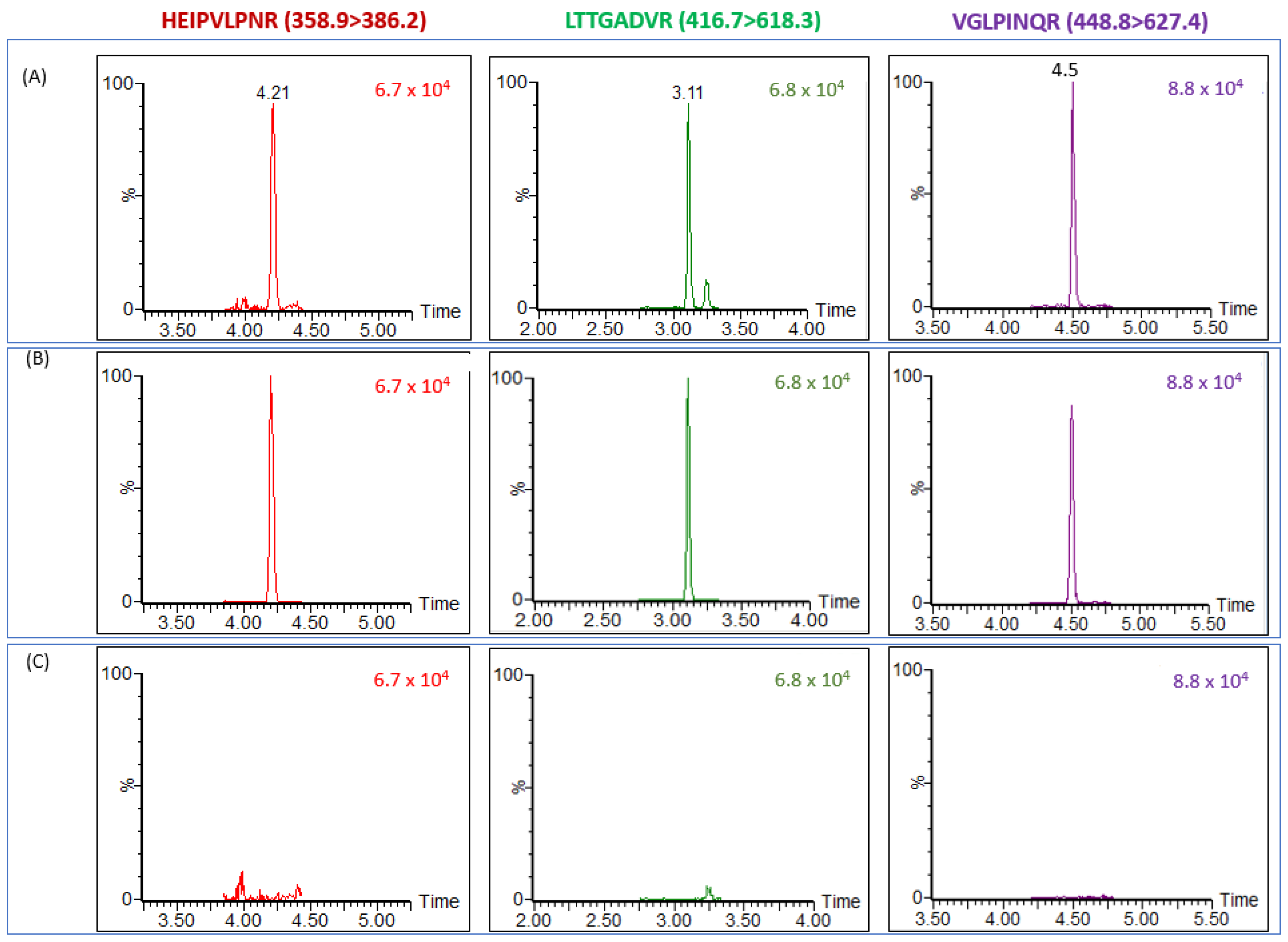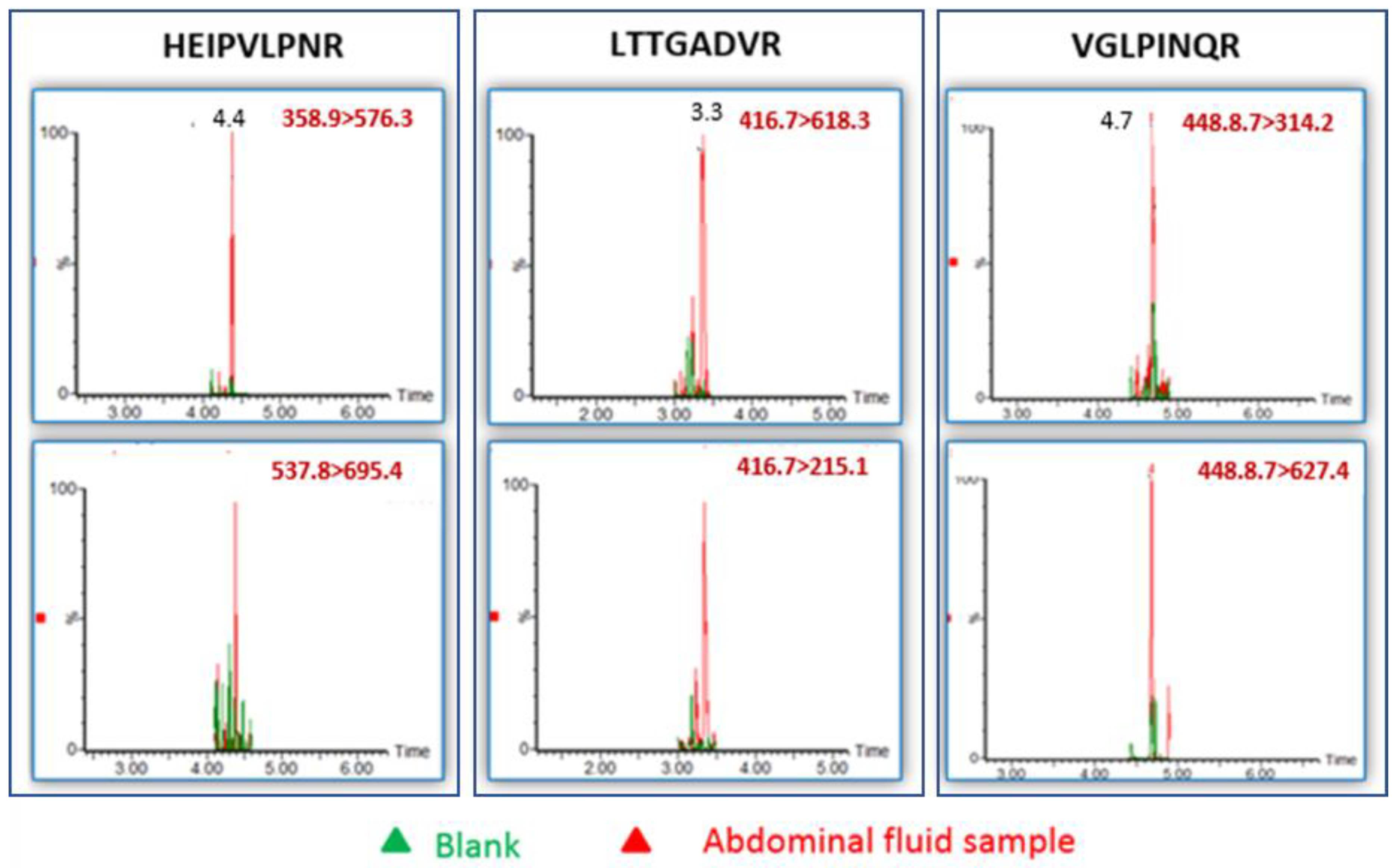Rapid, Sensitive and Reliable Ricin Identification in Serum Samples Using LC–MS/MS
Abstract
:1. Introduction
2. Results
2.1. Adjust the Protocol to Serum
2.2. Assay Performance and Validation in Serum Samples
2.3. Real Case Scenario
3. Discussion
4. Conclusions
5. Materials and Methods
5.1. Reagents
5.2. Ricin Production and Sample Preparation
5.3. Carbohydrate Binding Using LA Beads and Tryptic Digest of the Captured Ricin
5.4. LC/QqQ/MS-MS (MRM) Analysis
Author Contributions
Funding
Institutional Review Board Statement
Informed Consent Statement
Acknowledgments
Conflicts of Interest
References
- Bradberry, S.M.; Dickers, K.J.; Rice, P.; Griffiths, G.D.; Vale, J.A. Ricin poisoning. Toxicol. Rev. 2003, 22, 65–70. [Google Scholar] [CrossRef]
- Amukele, T.K.; Roday, S.; Schramm, V.L. Ricin A-chain activity on stem-loop and unstructured DNA substrates. Biochemistry 2005, 44, 4416–4425. [Google Scholar] [CrossRef] [PubMed]
- Simmons, B.M.; Stahl, P.D.; Russell, J.H. Mannose receptor-mediated uptake of ricin toxin and ricin A chain by macrophages. Multiple intracellular pathways for a chain translocation. J. Biol. Chem. 1986, 261, 7912–7920. [Google Scholar] [CrossRef]
- Janik, E.; Ceremuga, M.; Saluk-Bijak, J.; Bijak, M. Biological Toxins as the Potential Tools for Bioterrorism. Int. J. Mol. Sci. 2019, 20, 1181. [Google Scholar] [CrossRef] [PubMed] [Green Version]
- Schieltz, D.M.; McGrath, S.C.; McWilliams, L.G.; Rees, J.; Bowen, M.D.; Kools, J.J.; Dauphin, L.A.; Gomez-Saladin, E.; Newton, B.N.; Stang, H.L.; et al. Analysis of active ricin and castor bean proteins in a ricin preparation, castor bean extract, and surface swabs from a public health investigation. Forensic Sci. Int. 2011, 209, 70–79. [Google Scholar] [CrossRef]
- Worbs, S.; Köhler, K.; Pauly, D.; Avondet, M.A.; Schaer, M.; Dorner, M.B.; Dorner, B.G. Ricinus communis intoxications in human and veterinary medicine-a summary of real cases. Toxins 2011, 3, 1332–1372. [Google Scholar] [CrossRef] [Green Version]
- Jackson, L.S.; Zhang, Z.; Tolleson, W.H. Thermal stability of ricin in orange and apple juices. J. Food Sci. 2010, 75, T65–T71. [Google Scholar] [CrossRef]
- Centers for Disease Control and Prevention CDC. Investigation of a ricin-containing envelope at a postal facility—South Carolina, 2003. MMWR Morb. Mortal. Wkly. Rep. 2003, 52, 1129–1131. [Google Scholar]
- Bioterrorism Agents/Diseases. Centers for Disease Control and Prevention 2018. Available online: https://emergency.cdc.gov/agent/agentlist-category.asp (accessed on 3 December 2017).
- Verougstraete, N.; Helsloot, D.; Deprez, C.; Heylen, O.; Casier, I.; Croes, K. Lethal Injection of a Castor Bean Extract: Ricinine Quantification as a Marker for Ricin Exposure Using a Validated LC-MS/MS Method. J. Anal. Toxicol. 2019, 43, e1–e5. [Google Scholar] [CrossRef]
- Lopez Nunez, O.F.; Pizon, A.F.; Tamama, K. Ricin Poisoning after Oral Ingestion of Castor Beans: A Case Report and Review of the Literature and Laboratory Testing. J. Emerg. Med. 2017, 53, e67–e71. [Google Scholar] [CrossRef]
- Coopman, V.; De Leeuw, M.; Cordonnier, J.; Jacobs, W. Suicidal death after injection of a castor bean extract (Ricinus communis L.). Forensic Sci. Int. 2009, 189, e13–e20. [Google Scholar] [CrossRef] [PubMed]
- Falach, R.; Sapoznikov, A.; Alcalay, R.; Aftalion, M.; Ehrlich, S.; Makovitzki, A.; Agami, A.; Mimran, A.; Rosner, A.; Sabo, T.; et al. Generation of Highly Efficient Equine-Derived Antibodies for Post-Exposure Treatment of Ricin Intoxications by Vaccination with Monomerized Ricin. Toxins 2018, 10, 466. [Google Scholar] [CrossRef] [PubMed] [Green Version]
- Noy-Porat, T.; Alcalay, R.; Epstein, E.; Sabo, T.; Kronman, C.; Mazor, O. Extended therapeutic window for post-exposure treatment of ricin intoxication conferred by the use of high-affinity antibodies. Toxicon Off. J. Int. Soc. Toxinology 2017, 127, 100–105. [Google Scholar] [CrossRef] [PubMed]
- Respaud, R.; Marchand, D.; Pelat, T.; Tchou-Wong, K.M.; Roy, C.J.; Parent, C.; Cabrera, M.; Guillemain, J.; Mac Loughlin, R.; Levacher, E.; et al. Development of a drug delivery system for efficient alveolar delivery of a neutralizing monoclonal antibody to treat pulmonary intoxication to ricin. J. Control. Release Off. J. Control. Release Soc. 2016, 234, 21–32. [Google Scholar] [CrossRef] [PubMed]
- Ma, X.; Tang, J.; Li, C.; Liu, Q.; Chen, J.; Li, H.; Guo, L.; Xie, J. Identification and quantification of ricin in biomedical samples by magnetic immunocapture enrichment and liquid chromatography electrospray ionization tandem mass spectrometry. Anal. Bioanal. Chem. 2014, 406, 5147–5155. [Google Scholar] [CrossRef] [PubMed]
- Røen, B.T.; Opstad, A.M.; Haavind, A.; Tønsager, J. Serial ricinine levels in serum and urine after ricin intoxication. J. Anal. Toxicol. 2013, 37, 313–317. [Google Scholar] [CrossRef] [Green Version]
- Johnson, R.C.; Lemire, S.W.; Woolfitt, A.R.; Ospina, M.; Preston, K.P.; Olson, C.T.; Barr, J.R. Quantification of ricinine in rat and human urine: A biomarker for ricin exposure. J. Anal. Toxicol. 2005, 29, 149–155. [Google Scholar] [CrossRef] [Green Version]
- Isenberg, S.L.; Carter, M.D.; Miller, M.A.; Noras, A.I.; Mojica, M.A.; Carlsen, S.T.; Bulathsinghala, C.P.; Thomas, J.D.; Johnson, R.C. Quantification of Ricinine and Abrine in Human Plasma by HPLC-MS-MS: Biomarkers of Exposure to Ricin and Abrin. J. Anal. Toxicol. 2018, 42, 630–636. [Google Scholar] [CrossRef]
- Chen, H.Y.; Tran, H.; Foo, L.Y.; Sew, T.W.; Loke, W.K. Development and validation of an ELISA kit for the detection of ricin toxins from biological specimens and environmental samples. Anal. Bioanal. Chem. 2014, 406, 5157–5169. [Google Scholar] [CrossRef]
- Shyu, H.F.; Chiao, D.J.; Liu, H.W.; Tang, S.S. Monoclonal antibody-based enzyme immunoassay for detection of ricin. Hybrid. Hybridomics 2002, 21, 69–73. [Google Scholar] [CrossRef]
- Brandon, D.L. Detection of ricin contamination in ground beef by electrochemiluminescence immunosorbent assay. Toxins 2011, 3, 398–408. [Google Scholar] [CrossRef] [PubMed]
- Mechaly, A.; Cohen, H.; Cohen, O.; Mazor, O. A biolayer interferometry-based assay for rapid and highly sensitive detection of biowarfare agents. Anal. Biochem. 2016, 506, 22–27. [Google Scholar] [CrossRef] [PubMed]
- Falach, R.; Israeli, O.; Gal, Y.; Sapoznikov, A.; Shifman, O.; Ehrlich, S.; Aftalion, M.; Beth-Din, A.; Sabo, T.; Kronman, C. Identifying exposures to ribosome-inactivating proteins in blood samples: Amplification of ricin-induced ribosomal damage products enables sensitive detection of active toxin and circulating depurinated 28S rRNA. Forensic Toxicol. 2018, 36, 375–384. [Google Scholar] [CrossRef]
- Israeli, O.; Falach, R.; Sapoznikov, A.; Gal, Y.; Shifman, O.; Ehrlich, S.; Aftalion, M.; Beth-Din, A.; Kronman, C.; Sabo, T. Determination of ricin intoxication in biological samples by monitoring depurinated 28S rRNA in a unique reverse transcription-ligase-polymerase chain reaction assay. Forensic Toxicol. 2018, 36, 72–80. [Google Scholar] [CrossRef]
- Kalb, S.R.; Schieltz, D.M.; Becher, F.; Astot, C.; Fredriksson, S.; Barr, J.R. Recommended Mass Spectrometry-Based Strategies to Identify Ricin-Containing Samples. Toxins 2015, 7, 4881–4894. [Google Scholar] [CrossRef] [Green Version]
- Duracova, M.; Klimentova, J.; Fucikova, A.; Dresler, J. Proteomic Methods of Detection and Quantification of Protein Toxins. Toxins 2018, 10, 99. [Google Scholar] [CrossRef] [Green Version]
- Kalb, S.R.; Barr, J.R. Mass spectrometric detection of ricin and its activity in food and clinical samples. Anal. Chem. 2009, 81, 2037–2042. [Google Scholar] [CrossRef]
- Schieltz, D.M.; McWilliams, L.G.; Kuklenyik, Z.; Prezioso, S.M.; Carter, A.J.; Williamson, Y.M.; McGrath, S.C.; Morse, S.A.; Barr, J.R. Quantification of ricin, RCA and comparison of enzymatic activity in 18 Ricinus communis cultivars by isotope dilution mass spectrometry. Toxicon Off. J. Int. Soc. Toxinol. 2015, 95, 72–83. [Google Scholar] [CrossRef]
- Brinkworth, C.S.; Pigott, E.J.; Bourne, D.J. Detection of intact ricin in crude and purified extracts from castor beans using matrix-assisted laser desorption ionization mass spectrometry. Anal. Chem. 2009, 81, 1529–1535. [Google Scholar] [CrossRef]
- Feldberg, L.; Schuster, O.; Elhanany, E.; Laskar, O.; Yitzhaki, S.; Gura, S. Rapid and sensitive identification of ricin in environmental samples based on lactamyl agarose beads using LC-MS/MS (MRM). J. Mass Spectrom. JMS 2020, 55, e4482. [Google Scholar] [CrossRef]
- Worbs, S.; Skiba, M.; Bender, J.; Zeleny, R.; Schimmel, H.; Luginbühl, W.; Dorner, B.G. An International Proficiency Test to Detect, Identify and Quantify Ricin in Complex Matrices. Toxins 2015, 7, 4987–5010. [Google Scholar] [CrossRef] [PubMed] [Green Version]
- European Comission. 2002/657/EC: Commission Decision of 12 August 2002 implementing Council Directive 96/23/EC concerning the performance of analytical methods and the interpretation of results. Off. J. Eur. Communities 2002, 221, 8–36. [Google Scholar]
- Kanamori-Kataoka, M.; Kato, H.; Uzawa, H.; Ohta, S.; Takei, Y.; Furuno, M.; Seto, Y. Determination of ricin by nano liquid chromatography/mass spectrometry after extraction using lactose-immobilized monolithic silica spin column. J. Mass Spectrom. JMS 2011, 46, 821–829. [Google Scholar] [CrossRef] [PubMed]
- Gal, Y.; Sapoznikov, A.; Falach, R.; Ehrlich, S.; Aftalion, M.; Sabo, T.; Kronman, C. Potent Antiedematous and Protective Effects of Ciprofloxacin in Pulmonary Ricinosis. Antimicrob. Agents Chemother. 2016, 60, 7153–7158. [Google Scholar] [CrossRef] [PubMed] [Green Version]



| Fragment m/z (Type) | Parent Ion m/z (Multiple Charge) | Tryptic Peptide |
|---|---|---|
| LTTGADVR | 416.7 [(M + 2H)/2] +2 | 72.1 (Imm of Val) +1 |
| 86.1 (a3-H2O) +2 | ||
| 187.1 (a2) +1 | ||
| 215.1 (b2) +1 | ||
| 274.2 (y2) +1 | ||
| 398.2 (a5-H2O) +1 | ||
| 618.3 (y6) +1 | ||
| HEIPVLPNR | 537.8 [(M + 2H)/2] +2 | 70.1 (Imm of Pro) +1 |
| 110.1 (imm of His) +1 | ||
| 197.6 (x3-H2O) +2 | ||
| 267.1 (b2) +1 | ||
| 695.4 (y6) +1 | ||
| 358.9 [(M + 3H)/3] +3 | 70.1 (Imm of Pro) +1 | |
| 86.1 (Imm of Ile) +1 | ||
| 345.2 (b6) +2 | ||
| 386.2 (y3) +1 | ||
| 576.3 (b5) +1 | ||
| VGLPINQR | 448.8 [(M + 2H)/2] +2 | 86.1 (Imm of Leu) +1 |
| 157.1 (b2) +1 | ||
| 183.1 (x1-H2O) +1 | ||
| 225.2 (a3-NH3) +1 | ||
| 314.2 (y5) +2 | ||
| 530.3 (y4) +1 | ||
| 627.4 (y5) +1 |
| Markers | HEIPVLPNR | LTTGADVR | VGLPINQR | |||
|---|---|---|---|---|---|---|
| Transition | 359 > 576 | 359 > 386 | 416 > 215 | 416 > 618 | 449 > 314 | 449 > 627 |
| Average peak intensity | 33,992 ± 28% | 44,233 ± 28% | 20,952 ± 30% | 57,125 ± 27% | 48,508 ± 27% | 65,675 ± 29% |
| Average peptide intensity ratio | 1 | 1.7 ± 0.3 | 1.5 ± 0.3 | |||
| Average MRM transitions ratio | 1 | 1.5 ± 0.3 | 1 | 2.8 ± 0.5 | 1 | 1.4 ± 0.3 |
Publisher’s Note: MDPI stays neutral with regard to jurisdictional claims in published maps and institutional affiliations. |
© 2021 by the authors. Licensee MDPI, Basel, Switzerland. This article is an open access article distributed under the terms and conditions of the Creative Commons Attribution (CC BY) license (http://creativecommons.org/licenses/by/4.0/).
Share and Cite
Feldberg, L.; Elhanany, E.; Laskar, O.; Schuster, O. Rapid, Sensitive and Reliable Ricin Identification in Serum Samples Using LC–MS/MS. Toxins 2021, 13, 79. https://0-doi-org.brum.beds.ac.uk/10.3390/toxins13020079
Feldberg L, Elhanany E, Laskar O, Schuster O. Rapid, Sensitive and Reliable Ricin Identification in Serum Samples Using LC–MS/MS. Toxins. 2021; 13(2):79. https://0-doi-org.brum.beds.ac.uk/10.3390/toxins13020079
Chicago/Turabian StyleFeldberg, Liron, Eytan Elhanany, Orly Laskar, and Ofir Schuster. 2021. "Rapid, Sensitive and Reliable Ricin Identification in Serum Samples Using LC–MS/MS" Toxins 13, no. 2: 79. https://0-doi-org.brum.beds.ac.uk/10.3390/toxins13020079





